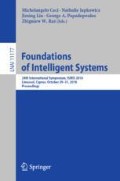Abstract
Wind speed forecasting is particularly important for wind farms due to cost-related issues, dispatch planning, and energy markets operations. This paper presents a multi-target learning method, in order to model historical wind speed data and yield accurate forecasts of the wind speed on the day-ahead (24 h) horizon. The proposed method is based on the analysis of historical data, which are represented at multiple scales in both space and time. Handling multi-scale data allows us to leverage the knowledge hidden in both the spatial and temporal variability of the shared information, in order to identify spatio-temporal aided patterns that contribute to yield accurate wind speed forecasts. The viability of the presented method is evaluated by considering benchmark data. Specifically, the empirical study shows that learning multi-scale historical data allows us to determine accurate wind speed forecasts.
Access this chapter
Tax calculation will be finalised at checkout
Purchases are for personal use only
Notes
- 1.
Multi-dimensional representations of geographic space can be equally dealt.
- 2.
The traditional multi-target predictive model \(f:\mathbf {X} \rightarrow \mathbf {Y}\) can be learned by neglecting information on the data variability.
- 3.
Information on the wind speed variability is included in the learning setting as a constraint to improve the predictive ability of the forecasting model learned.
References
Almeida, V., Gama, J.: Collaborative wind power forecast. In: Bouchachia, A. (ed.) ICAIS 2014. LNCS (LNAI), vol. 8779, pp. 162–171. Springer, Cham (2014). https://doi.org/10.1007/978-3-319-11298-5_17
Ambach, D., Vetter,P.: Wind speed and power forecasting - a review and incorporating asymmetric loss. In: 2016 Second International Symposium on Stochastic Models in Reliability Engineering, Life Science and Operations Management (SMRLO), pp. 115–123 (2016)
Appice, A., Džeroski, S.: Stepwise induction of multi-target model trees. In: Kok, J.N., Koronacki, J., Mantaras, R.L., Matwin, S., Mladenič, D., Skowron, A. (eds.) ECML 2007. LNCS (LNAI), vol. 4701, pp. 502–509. Springer, Heidelberg (2007). https://doi.org/10.1007/978-3-540-74958-5_46
Appice, A., Pravilovic, S., Lanza, A., Malerba, D.: Very short-term wind speed forecasting using spatio-temporal lazy learning. In: Japkowicz, N., Matwin, S. (eds.) DS 2015. LNCS (LNAI), vol. 9356, pp. 9–16. Springer, Cham (2015). https://doi.org/10.1007/978-3-319-24282-8_2
Ceci, M., Corizzo, R., Fumarola, F., Malerba, D., Rashkovska, A.: Predictive modeling of PV energy production: how to set up the learning task for a better prediction? IEEE Trans. Ind. Inf. 13(3), 956–966 (2017)
Hui, Z., Bin, L., Zhuo-qun, Z.: Short-term wind speed forecasting simulation research based on ARIMA-LSSVM combination method. In: ICMREE 2011, vol. 1, pp. 583–586 (2011)
Kavasseri, R.G., Seetharaman, K.: Day-ahead wind speed forecasting using f-ARIMA models. Renewable Energy 34(5), 1388–1393 (2009)
Kocev, D., Vens, C., Struyf, J., Dzeroski, S.: Tree ensembles for predicting structured outputs. Pattern Recognit. 46(3), 817–833 (2013)
Lange, M., Focken, U.: New developments in wind energy forecasting. In: 2008 IEEE Power and Energy Society General Meeting - Conversion and Delivery of Electrical Energy in the 21st Century, pp. 1–8 (2008)
Negnevitsky, M., Mandal, P., Srivastava, A.K.: An overview of forecasting problems and techniques in power systems. In: 2009 IEEE Power Energy Society General Meeting, pp. 1–4 (2009)
Palomares-Salas, J., De la Rosa, J., Ramiro, J., Melgar, J., Aguera, A., Moreno, A.: Arima vs. neural networks for wind speed forecasting. In: IEEE International Conference on Computational Intelligence for Measurement Systems and Applications, CIMSA 2009, pp. 129–133 (2009)
Pravilovic, S., Appice, A., Lanza, A., Malerba, D.: Mining cluster-based models of time series for wind power prediction. In: Greco, S., Picariello, A. (eds.) 22nd Italian Symposium on Advanced Database Systems, SEBD 2014, pp. 9–20 (2014)
Pravilovic, S., Appice, A., Lanza, A., Malerba, D.: Wind power forecasting using time series cluster analysis. In: Džeroski, S., Panov, P., Kocev, D., Todorovski, L. (eds.) DS 2014. LNCS (LNAI), vol. 8777, pp. 276–287. Springer, Cham (2014). https://doi.org/10.1007/978-3-319-11812-3_24
Pravilovic, S., Appice, A., Malerba, D.: An Intelligent technique for forecasting spatially correlated time series. In: Baldoni, M., Baroglio, C., Boella, G., Micalizio, R. (eds.) AI*IA 2013. LNCS (LNAI), vol. 8249, pp. 457–468. Springer, Cham (2013). https://doi.org/10.1007/978-3-319-03524-6_39
Pravilovic, S., Appice, A., Malerba, D.: Integrating cluster analysis to the ARIMA model for forecasting geosensor data. In: Andreasen, T., Christiansen, H., Cubero, J.-C., Raś, Z.W. (eds.) ISMIS 2014. LNCS (LNAI), vol. 8502, pp. 234–243. Springer, Cham (2014). https://doi.org/10.1007/978-3-319-08326-1_24
Pravilovic, S., Bilancia, M., Appice, A., Malerba, D.: Using multiple time series analysis for geosensor data forecasting. Inf. Sci. 380, 31–52 (2017)
Santamara-Bonfil, G., Reyes-Ballesteros, A., Gershenson, C.: Wind speed forecasting for wind farms: a method based on support vector regression. Renewable Energy 85, 790–809 (2016)
Shi, J., Qu, X., Zeng, S.: Short-term wind power generation forecasting: direct versus indirect arima-based approaches. Int. J. Green Energy 8(1), 100–112 (2011)
Soman, S.S., Zareipour, H., Malik, O., Mandal, P.: A review of wind power and wind speed forecasting methods with different time horizons. In: North American Power Symposium 2010, pp. 1–8 (2010)
Stojanova, D., Ceci, M., Appice, A., Malerba, D., Dzeroski, S.: Dealing with spatial autocorrelation when learning predictive clustering trees. Ecol. Inf. 13, 22–39 (2013)
Acknowledgments
Authors thank Enrico Laboragine for his support in developing the algorithm presented and running the experiments. This work is carried out in partial fulfillment of the research objectives of ATENEO Project 2014 on “Mining of network data” and ATENEO Project 2015 on“Models and Methods to Mine Complex and Large Data” funded by the University of Bari Aldo Moro.
Author information
Authors and Affiliations
Corresponding author
Editor information
Editors and Affiliations
Rights and permissions
Copyright information
© 2018 Springer Nature Switzerland AG
About this paper
Cite this paper
Appice, A., Lanza, A., Malerba, D. (2018). Handling Multi-scale Data via Multi-target Learning for Wind Speed Forecasting. In: Ceci, M., Japkowicz, N., Liu, J., Papadopoulos, G., Raś, Z. (eds) Foundations of Intelligent Systems. ISMIS 2018. Lecture Notes in Computer Science(), vol 11177. Springer, Cham. https://doi.org/10.1007/978-3-030-01851-1_34
Download citation
DOI: https://doi.org/10.1007/978-3-030-01851-1_34
Published:
Publisher Name: Springer, Cham
Print ISBN: 978-3-030-01850-4
Online ISBN: 978-3-030-01851-1
eBook Packages: Computer ScienceComputer Science (R0)

